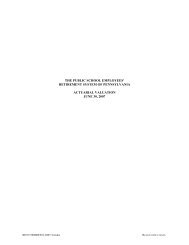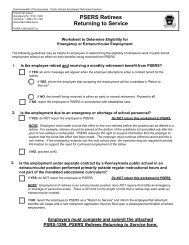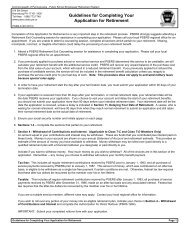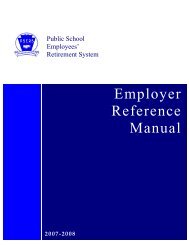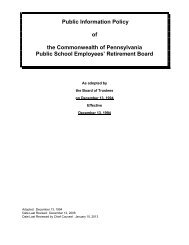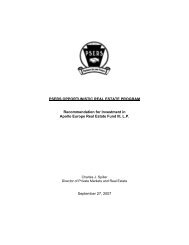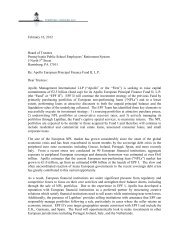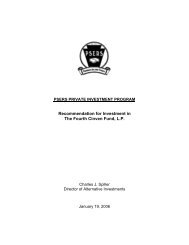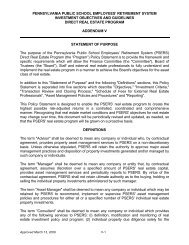a complete copy of the 2012 CAFR Report! - PSERs
a complete copy of the 2012 CAFR Report! - PSERs
a complete copy of the 2012 CAFR Report! - PSERs
Create successful ePaper yourself
Turn your PDF publications into a flip-book with our unique Google optimized e-Paper software.
Notes to Financial Statements (continued)<br />
(B) Deposit and Investment Risk Disclosures<br />
i. Deposits<br />
Custodial credit risk for deposits is <strong>the</strong> risk that, in <strong>the</strong><br />
event <strong>of</strong> a financial institution failure, <strong>the</strong> System would<br />
not be able to recover <strong>the</strong> value <strong>of</strong> <strong>the</strong> deposits. The<br />
Commonwealth’s Treasury Department is <strong>the</strong> custodian <strong>of</strong><br />
<strong>the</strong> System’s funds. Commonwealth Treasury Department<br />
deposits must be held in insured depositories approved by<br />
<strong>the</strong> Commonwealth’s Board <strong>of</strong> Finance and Revenue and<br />
must be fully collateralized.<br />
The System, through its third party administrator, maintains<br />
certain bank deposits for <strong>the</strong> operation <strong>of</strong> its voluntary<br />
HOP. These deposits are not required to be collateralized<br />
by statute or policy. These deposits totaled $69,588,000<br />
and $57,924,000 at June 30, <strong>2012</strong> and 2011, respectively,<br />
and are under <strong>the</strong> custody <strong>of</strong> M&T Bank which has an A-<br />
rating by Standard and Poor’s (S&P) and an A3 rating by<br />
Moody’s Investor Services (Moody’s).<br />
ii. Investment Risks<br />
The System’s investments, including derivatives and o<strong>the</strong>r<br />
similar investments, may be subject to various risks. Among<br />
<strong>the</strong>se risks are concentration <strong>of</strong> credit risk, custodial credit<br />
risk, credit risk, interest rate risk, and foreign currency risk.<br />
The policies addressing each one <strong>of</strong> <strong>the</strong>se risks, discussed<br />
in more detail below, are contained within <strong>the</strong> Investment<br />
Policy Statement, Objectives, and Guidelines reviewed<br />
and approved annually by <strong>the</strong> Board. Due to <strong>the</strong> level<br />
<strong>of</strong> risk associated with certain investments, it is possible<br />
that changes in <strong>the</strong> values <strong>of</strong> investments may occur in <strong>the</strong><br />
near term and that such changes could materially affect <strong>the</strong><br />
amounts reported in <strong>the</strong> Statements <strong>of</strong> Plan Net Assets.<br />
(a) Concentration <strong>of</strong> Credit Risk<br />
Concentration <strong>of</strong> credit risk is <strong>the</strong> risk <strong>of</strong> loss attributed to<br />
<strong>the</strong> magnitude <strong>of</strong> <strong>the</strong> System’s investment in a single issuer.<br />
As <strong>of</strong> June 30, <strong>2012</strong> and 2011 <strong>the</strong> System had no single<br />
issuer that exceeded 5% <strong>of</strong> total investments. Investments<br />
issued or explicitly guaranteed by <strong>the</strong> U.S. government and<br />
investments in mutual funds, external investment pools,<br />
and o<strong>the</strong>r pooled investments were excluded.<br />
(b) Custodial Credit Risk<br />
Custodial credit risk for investments is <strong>the</strong> risk that, in <strong>the</strong><br />
event <strong>of</strong> <strong>the</strong> failure <strong>of</strong> <strong>the</strong> counterparty to a transaction, <strong>the</strong><br />
System would not be able to recover <strong>the</strong> value <strong>of</strong> investment<br />
or collateral securities that are in <strong>the</strong> possession <strong>of</strong> an outside<br />
party. In accordance with a contractual relationship between<br />
FINANCIAL SECTION<br />
PAGE 50<br />
<strong>the</strong> Commonwealth’s Treasury Department and its custodial<br />
agent, substantially all investments, where securities are<br />
used as evidence <strong>of</strong> <strong>the</strong> investment, are held by <strong>the</strong> custodian<br />
in book-entry form in <strong>the</strong> System’s name. Those investments<br />
are defined as insured or registered investments for which<br />
<strong>the</strong> securities are held by <strong>the</strong> System or its agent and,<br />
<strong>the</strong>refore, have a very minimal level <strong>of</strong> custodial credit risk.<br />
The remaining investments, which do not have securities<br />
that are used as evidence <strong>of</strong> <strong>the</strong> investment, are primarily<br />
in collective trust funds and limited partnerships, which<br />
include real estate and alternative investments.<br />
(c) Credit Risk<br />
Credit risk is <strong>the</strong> risk that an issuer or o<strong>the</strong>r counterparty to<br />
an investment will not fulfill its obligations. The credit risk<br />
<strong>of</strong> a debt instrument is measured by nationally recognized<br />
statistical rating organizations (NRSRO) such as Fitch<br />
Investor Services (Fitch), Moody’s, and S&P. Annually, <strong>the</strong><br />
Board establishes an asset allocation plan. This plan manages<br />
<strong>the</strong> overall credit risk <strong>of</strong> <strong>the</strong> fixed income asset class through<br />
a clearly defined long-term asset allocation policy. This<br />
policy establishes a long-term target allocation <strong>of</strong> <strong>the</strong> fixed<br />
income asset class at 26.2% <strong>of</strong> <strong>the</strong> investment portfolio. The<br />
fixed income target allocation consists <strong>of</strong>:<br />
• An allocation <strong>of</strong> 5.2% <strong>of</strong> <strong>the</strong> portfolio has been made<br />
to <strong>the</strong> U.S. core plus segment <strong>of</strong> <strong>the</strong> fixed income asset<br />
class benchmarked to <strong>the</strong> Barclays Capital U.S. Aggregate<br />
Index. The U.S. core plus allocation is composed <strong>of</strong><br />
primarily investment grade, relatively liquid, public<br />
domestic bonds with an overall weighted-average NRSRO<br />
credit rating <strong>of</strong> A or better.<br />
• An allocation <strong>of</strong> 6.0% <strong>of</strong> <strong>the</strong> portfolio has been made to<br />
<strong>the</strong> high yield segment <strong>of</strong> <strong>the</strong> fixed income asset class<br />
benchmarked to <strong>the</strong> Barclays Capital U.S. High Yield<br />
Index. The high yield allocation is composed <strong>of</strong> less liquid<br />
public non-investment grade fixed income securities with<br />
an overall weighted-average NRSRO credit rating <strong>of</strong> B- or<br />
better.<br />
• An allocation <strong>of</strong> 5.0% <strong>of</strong> <strong>the</strong> portfolio has been made<br />
to <strong>the</strong> Treasury Inflation-Protected Securities (TIPS)<br />
segment <strong>of</strong> <strong>the</strong> fixed income asset class benchmarked<br />
to <strong>the</strong> Barclays Capital U.S. TIPS Index and composed<br />
<strong>of</strong> primarily government issued TIPS with an overall<br />
weighted-average NRSRO credit rating <strong>of</strong> AA or better.<br />
The portfolio manager is permitted to leverage <strong>the</strong><br />
portfolio using TIPS total return swaps up to 3:1.<br />
• An allocation <strong>of</strong> 3.0% <strong>of</strong> <strong>the</strong> portfolio has been made<br />
to <strong>the</strong> non-U.S. developed markets fixed income asset<br />
class benchmarked to <strong>the</strong> Barclays Capital Global<br />
Aggregate GDP-weighted Developed Market ex-U.S.




